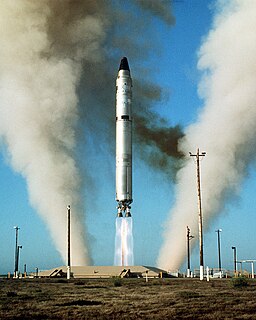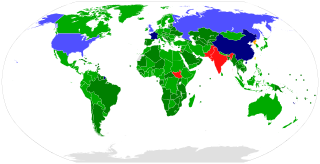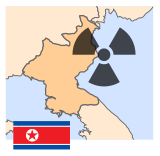 |
|
A North Korean missile test occurred on May 29 and 30, 1993. North Korea fired a Nodong-1 missile into the Sea of Japan (East Sea of Korea), from a base in Hwadae County near Wonsan, North Korea. The target was a buoy floating in the Sea of Japan. The North Koreans were testing the missile so they could export it to Iran in return for oil. [1] Japanese and United States officials waited a few days before disclosing the launch of the missile. Afterwards, North Korea reaffirmed its commitment to the Nuclear Non-Proliferation Treaty.

North Korea, officially the Democratic People's Republic of Korea, is a country in East Asia constituting the northern part of the Korean Peninsula, with Pyongyang the capital and the largest city in the country. To the north and northwest, the country is bordered by China and by Russia along the Amnok and Tumen rivers and to the south it is bordered by South Korea, with the heavily fortified Korean Demilitarized Zone (DMZ) separating the two. Nevertheless, North Korea, like its southern counterpart, claims to be the legitimate government of the entire peninsula and adjacent islands.
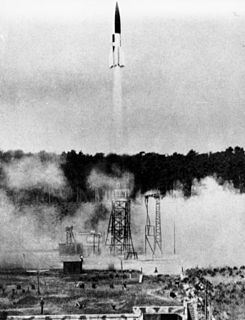
In military language, a missile, also known as a guided missile, is a guided self-propelled flying weapon usually propelled by a jet engine or rocket motor. This is in contrast to an unguided self-propelled flying munition, referred to as a rocket. Missiles have four system components: targeting or missile guidance, flight system, engine, and warhead. Missiles come in types adapted for different purposes: surface-to-surface and air-to-surface missiles, surface-to-air missiles, air-to-air missiles, and anti-satellite weapons. Non-self-propelled airborne explosive devices are generally referred to as shells and usually have a shorter range than missiles. In ordinary language the word means an object which can be thrown, shot, or propelled toward a target.

The Sea of Japan is the marginal sea between the Japanese archipelago, Sakhalin, the Korean Peninsula and Russia. The Japanese archipelago separates the sea from the Pacific Ocean. It is bordered by Japan, Korea and Russia. Like the Mediterranean Sea, it has almost no tides due to its nearly complete enclosure from the Pacific Ocean. This isolation also reflects in the fauna species and in the water salinity, which is lower than in the ocean. The sea has no large islands, bays or capes. Its water balance is mostly determined by the inflow and outflow through the straits connecting it to the neighboring seas and Pacific Ocean. Few rivers discharge into the sea and their total contribution to the water exchange is within 1%.
The missile launches were the culmination of several months' planning and bargaining with Iran, and what was suggested to be a plot between Iran and North Korea to develop weapons capable of striking Japan. It began in March 1993, with North Korea receiving several shipments of "special metals" designated for the construction of missile launch pads. [2] [ full citation needed ] Later, a Russian report indicated that North Korea was in the market for "missile specialists" in order to turn their missile production into a more profitable venture. Russian officials were further incensed after detaining a group of Russian nuclear physicists and rocket scientists attempting to enter North Korea. North Korea later pledged not to use Russian scientists and technicians, after being threatened with cut diplomatic ties by Russia.
In January of that year, the commander of the Iranian Revolution Guard Corps, Mohsen Rezaee, went to Pyongyang to finalize a 2.7 billion dollar purchase of around 300 Scud missiles from North Korea. [2] Around the same time, the Iranian delegation came to watch the final Nodong-1 tests and North Korea announced its withdrawal from the Nuclear Non-Proliferation Treaty. It was suspected upon successful testing of the missiles, Iran intended to trade oil for the Nodong missiles, as Iran is a primary contributor of North Korea's oil (over 40%). [2]

The Islamic Revolutionary Guard Corps (IRGC) is a branch of the Iranian Armed Forces, founded after the Iranian Revolution on 22 April 1979 by order of Ayatollah Ruhollah Khomeini. Whereas the Iranian Army defends Iranian borders and maintains internal order, according to the Iranian constitution, the Revolutionary Guard (pasdaran) is intended to protect the country's Islamic republic political system. The Revolutionary Guards state that their role in protecting the Islamic system is preventing foreign interference as well as coups by the military or "deviant movements".

Mohsen Rezaee Mirgha'ed is an Iranian conservative politician affiliated with the Resistance Front of Islamic Iran and senior military officer in the Islamic Revolutionary Guard Corps who currently holds office as the secretary of the Expediency Discernment Council.
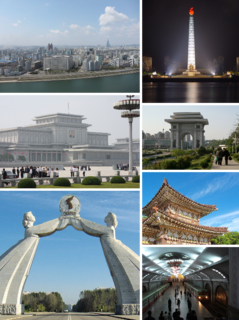
Pyongyang, P'yŏngyang or Pyeongyang, is the capital and largest city of North Korea. Pyongyang is located on the Taedong River about 109 kilometres (68 mi) upstream from its mouth on the Yellow Sea. According to the 2008 population census, it has a population of 3,255,288. It is a directly-administered city with equal status to North Korean provinces.

